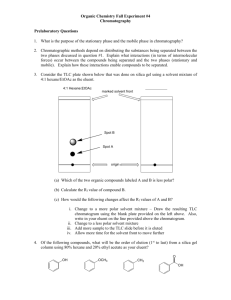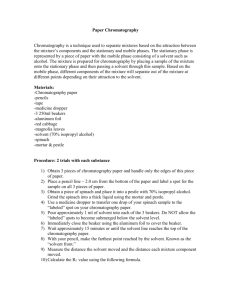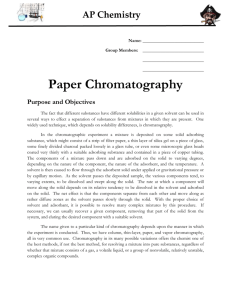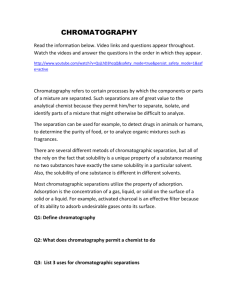16 Chromatography
advertisement
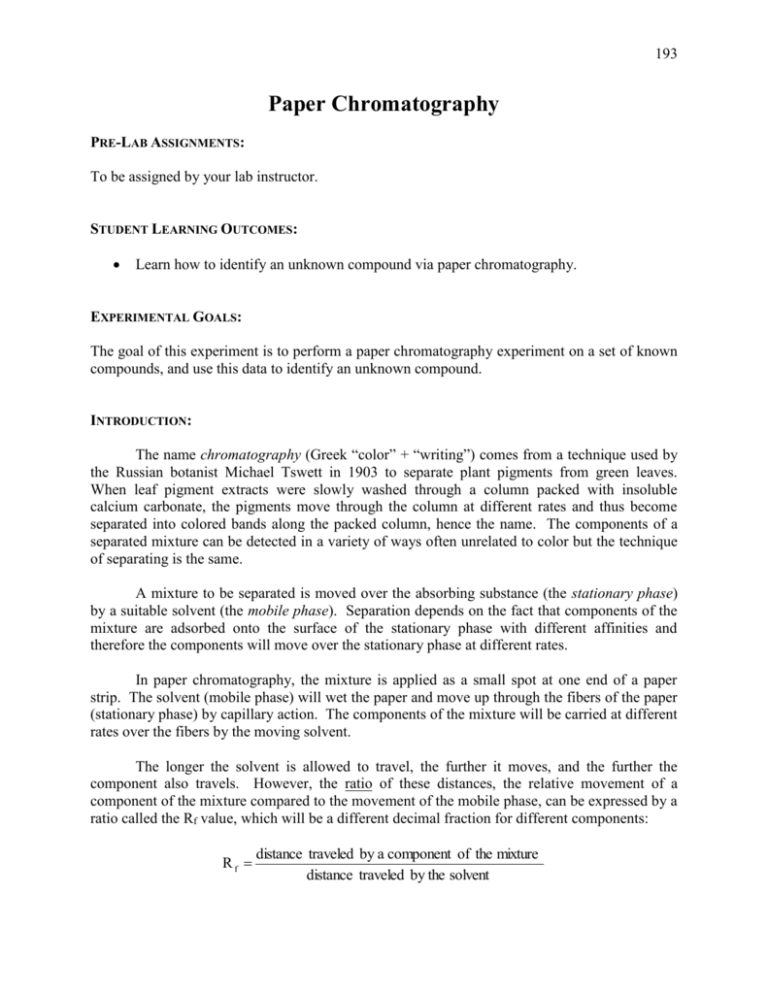
193 Paper Chromatography PRE-LAB ASSIGNMENTS: To be assigned by your lab instructor. STUDENT LEARNING OUTCOMES: Learn how to identify an unknown compound via paper chromatography. EXPERIMENTAL GOALS: The goal of this experiment is to perform a paper chromatography experiment on a set of known compounds, and use this data to identify an unknown compound. INTRODUCTION: The name chromatography (Greek “color” + “writing”) comes from a technique used by the Russian botanist Michael Tswett in 1903 to separate plant pigments from green leaves. When leaf pigment extracts were slowly washed through a column packed with insoluble calcium carbonate, the pigments move through the column at different rates and thus become separated into colored bands along the packed column, hence the name. The components of a separated mixture can be detected in a variety of ways often unrelated to color but the technique of separating is the same. A mixture to be separated is moved over the absorbing substance (the stationary phase) by a suitable solvent (the mobile phase). Separation depends on the fact that components of the mixture are adsorbed onto the surface of the stationary phase with different affinities and therefore the components will move over the stationary phase at different rates. In paper chromatography, the mixture is applied as a small spot at one end of a paper strip. The solvent (mobile phase) will wet the paper and move up through the fibers of the paper (stationary phase) by capillary action. The components of the mixture will be carried at different rates over the fibers by the moving solvent. The longer the solvent is allowed to travel, the further it moves, and the further the component also travels. However, the ratio of these distances, the relative movement of a component of the mixture compared to the movement of the mobile phase, can be expressed by a ratio called the Rf value, which will be a different decimal fraction for different components: Rf distance traveled by a component of the mixture distance traveled by the solvent 194 In this experiment, you will use paper chromatography to separate components of a mixture of dyes called acid-base indicators. By comparing the Rf values of the components of your unknown with Rf values for known dyes, you will identify which dyes are present in your mixture. You will also be able to use the colors of the dyes to aid your identification. PROCEDURE: 1. If not already present, draw a pencil line across the paper through the center of the unknown spot (starting line). Make four evenly spaced labels across the pencil line to indicate where to place the known compounds, and label them in pencil with the initials of the known dye compounds. Record the unknown number written on the chromatogram on your report sheet. # X X X X 2. Use capillary pipets to make small spots of the four known components on the pencil line. 3. Suspend the paper in a beaker by hanging a small fold at the top of the paper from a rubber band stretched around the beaker. The paper should almost touch the bottom of the beaker. 195 4. Using a long-stemmed funnel, add enough developing solution to touch the bottom of the paper. The solvent must not cover pencil line and spots. 5. Immediately cover the beaker with plastic wrap to keep the atmosphere inside the beaker saturated with solvent vapor so that the solvent will not evaporate from the paper fibers as the solvent moves up the paper. Do not move the developing chamber once the paper has been immersed in the developing solution. 6. Wait for the solvent front to get high enough so that all components of the mixture are well separated, (about 45 minutes to 1 hour), then remove the chromatogram and immediately mark the solvent front with a pencil. Pour the developing solvent into the bottle labeled “Recovery Bottle” and wash out the beaker in the hood. 7. When the solvent has dried, measure the distance from the starting line to the leading edge of each spot on the chromatogram, and measure the distance that the solvent moved above the starting line. Make all measurements in units of mm. # solvent front distance solvent moved distance spot moved X X X X 8. Calculate Rf values for the knowns and for each component of the unknown mixture, and record the color of each dried spot. 9. Hold the chromatogram over an open container of concentrated hydrochloric acid (HCl) under the hood. Record the color of each spot. 10. Hold the chromatogram over an open container of ammonium hydroxide (NH4OH) under the hood. Record the color of each spot. 11. By comparing the Rf values and colors of your unknown spots with those for the known spots, identify the components present in your unknown mixture. 12. Pour the remaining developing solvent in the Recovery Bottle in the hood. Wash and dry the beaker, and return the apparatus to the stockroom. 14. Staple your chromatogram to your report sheet. 196 197 LAB REPORT: Paper Chromatography Name ________________________________ Date _________ Partner ________________________________ Section _________ Distance Solvent Moved (mm) Distance Sample Moved (mm) Rf Congo Red Phenol Red Bromcresol Green Methyl Violet Unknown No._____ Unknown contains: ______________________________ ______________________________ ______________________________ ______________________________ Show Rf calculations on the back of this sheet Color When Dry Report Grade ______ Color in HCl Vapor Color in NH4OH Vapor 198 Rf Calculations: Congo Red Phenol Red Bromcresol Green Methyl Violet Unknowns




